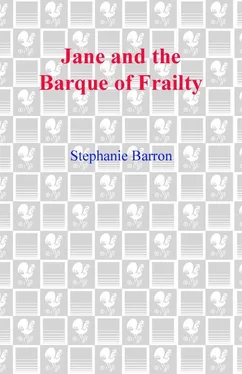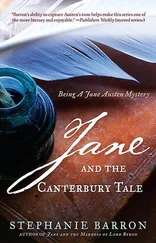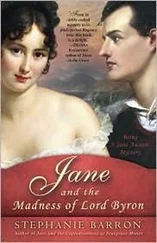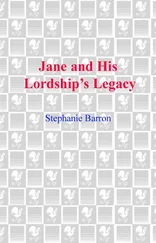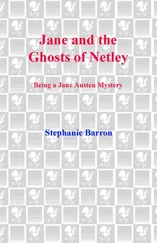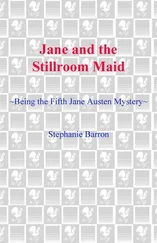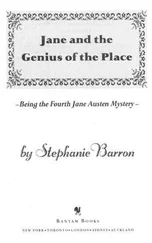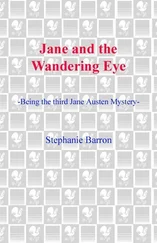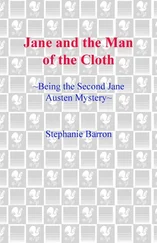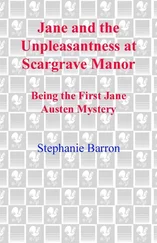Stephanie Barron - Jane and the Barque of Frailty
Здесь есть возможность читать онлайн «Stephanie Barron - Jane and the Barque of Frailty» весь текст электронной книги совершенно бесплатно (целиком полную версию без сокращений). В некоторых случаях можно слушать аудио, скачать через торрент в формате fb2 и присутствует краткое содержание. Жанр: Исторический детектив, Иронический детектив, на английском языке. Описание произведения, (предисловие) а так же отзывы посетителей доступны на портале библиотеки ЛибКат.
- Название:Jane and the Barque of Frailty
- Автор:
- Жанр:
- Год:неизвестен
- ISBN:нет данных
- Рейтинг книги:4 / 5. Голосов: 1
-
Избранное:Добавить в избранное
- Отзывы:
-
Ваша оценка:
- 80
- 1
- 2
- 3
- 4
- 5
Jane and the Barque of Frailty: краткое содержание, описание и аннотация
Предлагаем к чтению аннотацию, описание, краткое содержание или предисловие (зависит от того, что написал сам автор книги «Jane and the Barque of Frailty»). Если вы не нашли необходимую информацию о книге — напишите в комментариях, мы постараемся отыскать её.
Jane and the Barque of Frailty — читать онлайн бесплатно полную книгу (весь текст) целиком
Ниже представлен текст книги, разбитый по страницам. Система сохранения места последней прочитанной страницы, позволяет с удобством читать онлайн бесплатно книгу «Jane and the Barque of Frailty», без необходимости каждый раз заново искать на чём Вы остановились. Поставьте закладку, и сможете в любой момент перейти на страницу, на которой закончили чтение.
Интервал:
Закладка:
Readers of this detective amusement may be interested to learn the fates of some of its characters. Emmanuel, Comte d’Entraigues, and his wife, Anne de St.-Huberti, were murdered at their home in Barnes, Surrey, on July 22, 1812. They were discovered in bed with their throats slit; and a household servant was charged with the crime. When the news of this horror reached Jane, she must have experienced a certain sense of what we would call closure. D’Entraigues’s biographer suggests that during his lifetime he was employed as a spy against England by several governments, Russia and France being among them; but he was also certainly employed by George Canning, to provide intelligence to England of those nations’ intentions. The confusion of motives, policy, and fact that Lord Harold Trowbridge described in his 1808 journal, while analyzing the turf battles between Castlereagh and Canning, probably resulted from the deliberate design of Canning’s chief spy — Comte d’Entraigues. Which of the governments and patrons d’Entraigues regarded as meriting his true allegiance — if he was capable of any — is difficult to know; but he certainly promoted distrust between Russia and Great Britain. Those who wish to know more of his life may consult Léonce Pingaud, Un agent secret sous la Révolution et l’Empire: Le Comte d’Antraigues (sic) (Paris, 1894).
Julien, Comte d’Entraigues, lived out his life in London in a home in Montague Place, Russell Square, dying in 1861.
Spencer Perceval, who led the government during Jane’s visit to London, was assassinated in Parliament May 11, 1812. The Regent asked the Tory Lord Liverpool to form a new cabinet, and Lord Castlereagh to serve as foreign secretary — a post he held until his death. George Canning, who had wished to be named to that portfolio, was given nothing in 1812; Lord Moira was named governor-general of Bengal, where he lived for nine years. In 1817 he was made Marquis of Hastings.
Lord Castlereagh’s later career was not untouched by scandal. In 1822, having acceded to his father’s estates and title as Marquis of Londonderry, he began to receive blackmailing letters accusing him of homosexuality. Apparently, as Castlereagh told the story, he had been seen entering a brothel with a prostitute he later learned was a transvestite male. Whatever the truth of the situation, by mid-August of that year, Castlereagh was subject to a severe mental collapse and depression; he confessed his “crimes” to both the Prince Regent and the Duke of Wellington — two of his closest friends — and despite being under the watchful guard of his medical doctor, slit his throat with a razor.
The chief biographer of both Canning and Castlereagh is Wendy Hinde, whose workmanlike studies of the celebrated Regency statesmen, George Canning (London: William Collins Sons, 1973) and Castlereagh (London: William Collins Sons, 1981) are well worth reading.
Stephanie Barron
Golden, Colorado
September 2005
Примечания
1
In a letter to her sister, Cassandra, dated April 25, 1811, Jane states that Henry gave up their tickets for this performance, and that she was unable to see Mrs. Siddons — a curious prevarication, in light of this text. — Editor’s note.
2
A charley, as London’s night watchmen were termed, was supposed to make the rounds of his neighborhood every half hour during a set period of work — usually twelve hours at a stretch — and could rest in his wooden booth when not so employed. In point of fact, however, many such watchmen never bothered to make the rounds but drew their minimal pay for huddling in their boxes and periodically announcing the time and weather. They were frequently bribed by prostitutes and petty thieves to ignore minor acts of crime; they were also subject to being overturned in their booths by drunken young gentlemen. At this time there was no regular police force in London. — Editor’s note.
3
In June 1809, the Portland Cabinet authorized a military campaign to take the Island of Walcheren, in the Dutch river Scheldt, held by Napoleon. The object was to destroy the arsenals and dockyards at Antwerp and Flushing. Some 40,000 troops and 250 vessels were dispatched in a well-publicized raid, conducted with poor intelligence and worse weather. By August, the Cabinet ordered a withdrawal. The Walcheren campaign has gone down in history as a fiasco. — Editor’s note .
4
This part of the fashionable West End is now Cadogan Square. Hans Town was named for Sir Hans Sloane, whose daughter married the first Earl of Cadogan in the 1770s, uniting the two families’ estates. Architect Henry Holland leased the area and built the original brick houses, many of which were altered in subsequent centuries. — Editor’s note .
5
In Austen’s day, a sister-in-law such as Eliza de Feuillide would be referred to as a “sister” once she married Jane’s brother Henry. The fact of Eliza’s being also Jane and Henry’s first cousin makes for a tightly knit relationship. — Editor’s note.
6
Jane’s elder brother, Edward, was adopted by his distant cousin, Thomas Knight, who bequeathed extensive estates in Kent and Hampshire to Edward. — Editor’s note.
7
To be “warm” in Jane’s day was to be wealthy. According to Charles Greville, a contemporary of Austen’s, Rundell was so rich he was able to lend money to his bankers during the financial panic that followed Waterloo. When he died at the age of eighty, Greville notes, Rundell left the largest fortune then registered under a will at Doctors Commons — some million and a half pounds. — Editor’s note .
8
Princess Caroline of Brunswick was the estranged wife of the Prince Regent, later George IV. — Editor’s note .
9
This was the traditional meeting ground of duelists, outside London. — Editor’s note .
10
Mort was a cant term for woman. — Editor's note .
11
Bow Street Runners were not public servants but professional thief-takers more akin to our present-day bounty hunters. They typically worked for a percentage of the value of any stolen goods recovered; this was their “prize money.” As the jewelry belonged to Princess Tscholikova, presumably her family would pay the reward once the gems were recovered. This pursuit of gain made Bow Street Runners typically less interested in justice or the guilt or innocence of those they pursued, and more intent upon the simple recovery of goods. Although they were empowered to arrest suspects and bring them before the magistrate, justice was for the court to determine. — Editor’s note .
12
General Sir John Moore was killed in the British evacuation from Corunna in January 1809.— Editor’s note.
13
The Upper Ten Thousand were the aristocracy of England; the haut ton. — Editor’s note .
14
Dun Territory was a cant term for indebtedness, as those who owed money were “dunned” by bill collectors. — Editor’s note .
15
The Ministry of All Talents united notable Tory and Whig political figures under the leadership of Thomas Grenville and Charles James Fox in 1806. — Editor’s note .
16
The present-day equivalent of 1810 British pounds may be calculated roughly by a factor of sixty; the value in present-day dollars, by a factor of one hundred. Thus, Jane scraped by on an income roughly equivalent to three thousand present-day British pounds per annum, while the Prince’s debts discharged by Parliament were roughly equivalent to thirty-six million present-day pounds. His annual income was in the neighborhood of 3.6 million. — Editor’s note .
Читать дальшеИнтервал:
Закладка:
Похожие книги на «Jane and the Barque of Frailty»
Представляем Вашему вниманию похожие книги на «Jane and the Barque of Frailty» списком для выбора. Мы отобрали схожую по названию и смыслу литературу в надежде предоставить читателям больше вариантов отыскать новые, интересные, ещё непрочитанные произведения.
Обсуждение, отзывы о книге «Jane and the Barque of Frailty» и просто собственные мнения читателей. Оставьте ваши комментарии, напишите, что Вы думаете о произведении, его смысле или главных героях. Укажите что конкретно понравилось, а что нет, и почему Вы так считаете.
